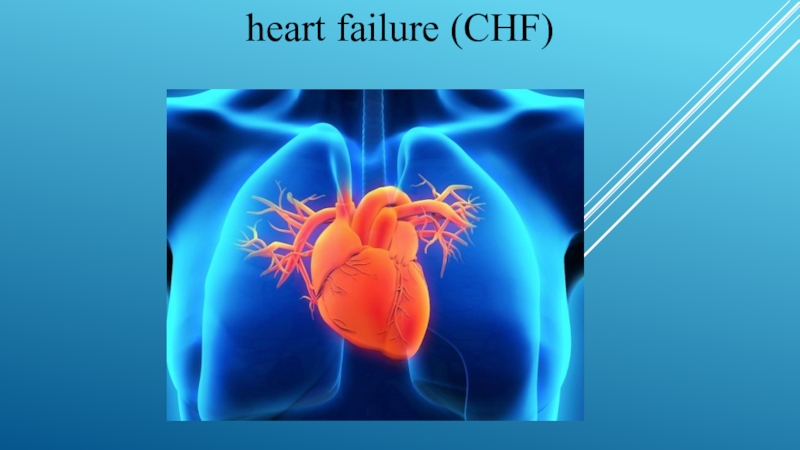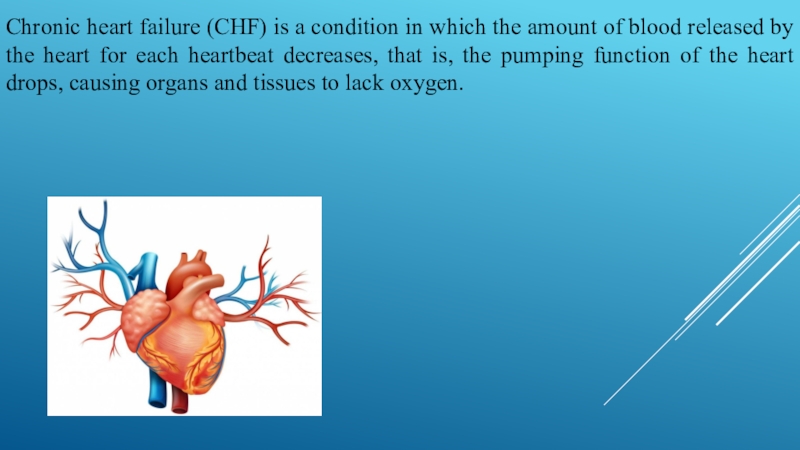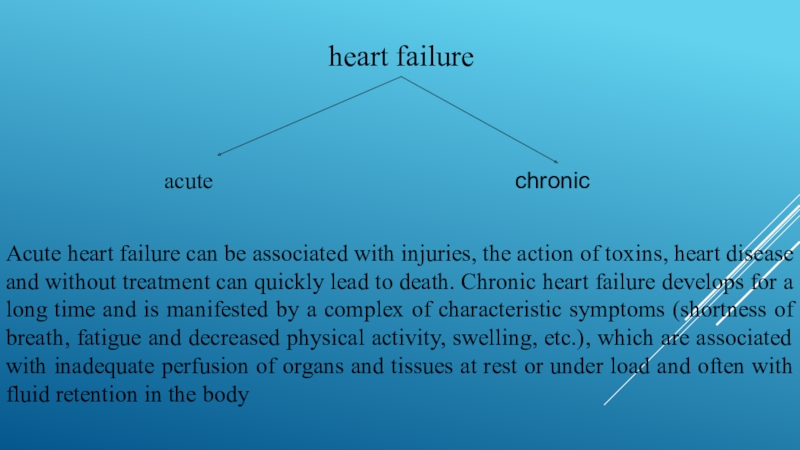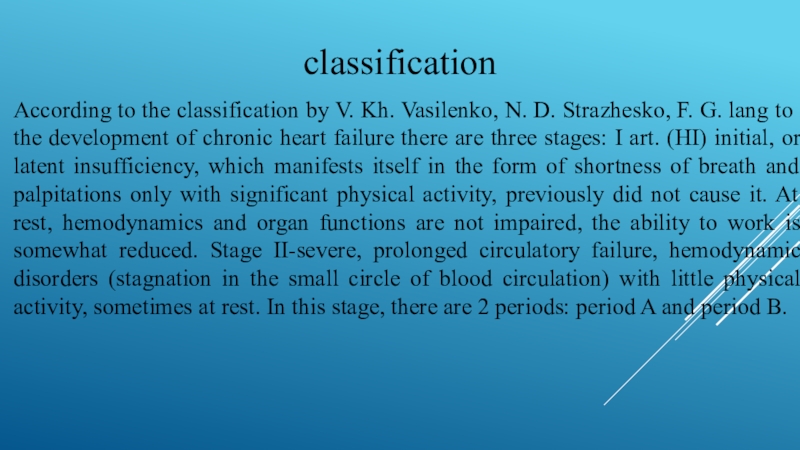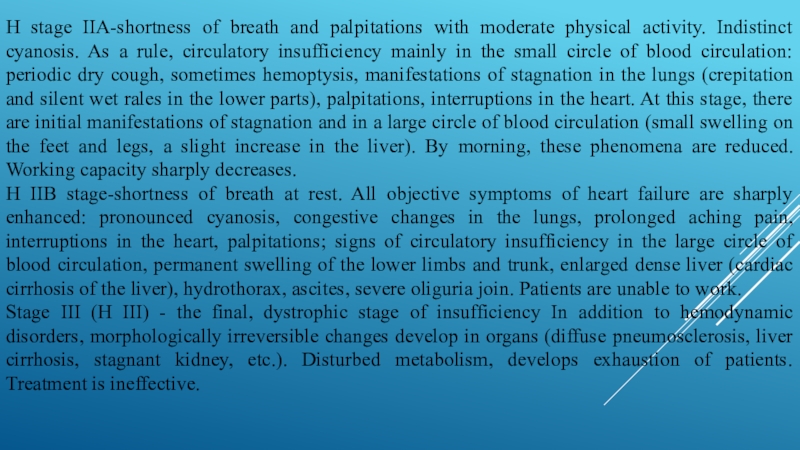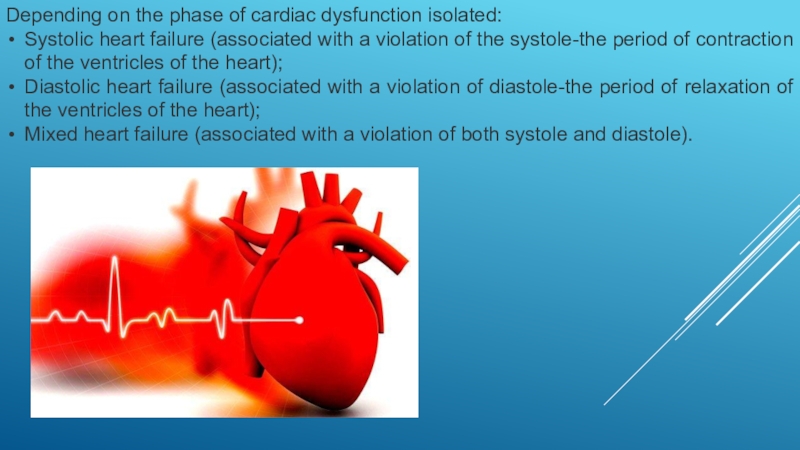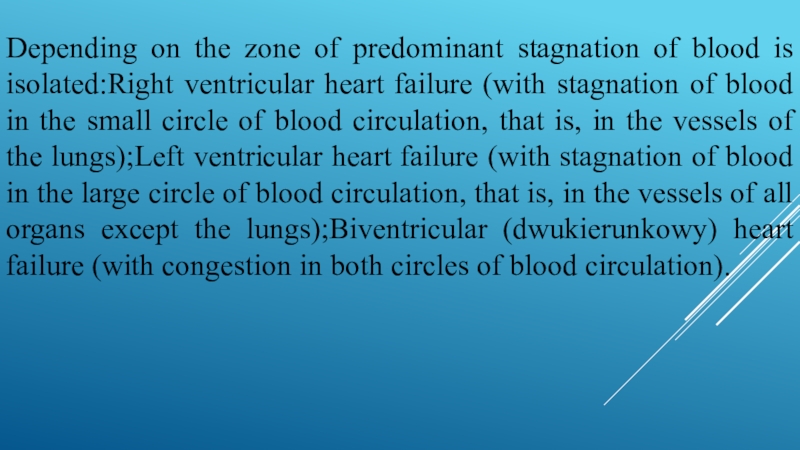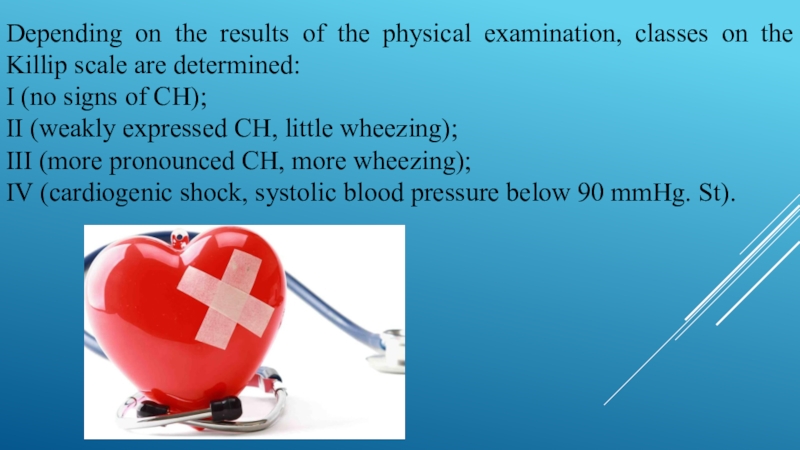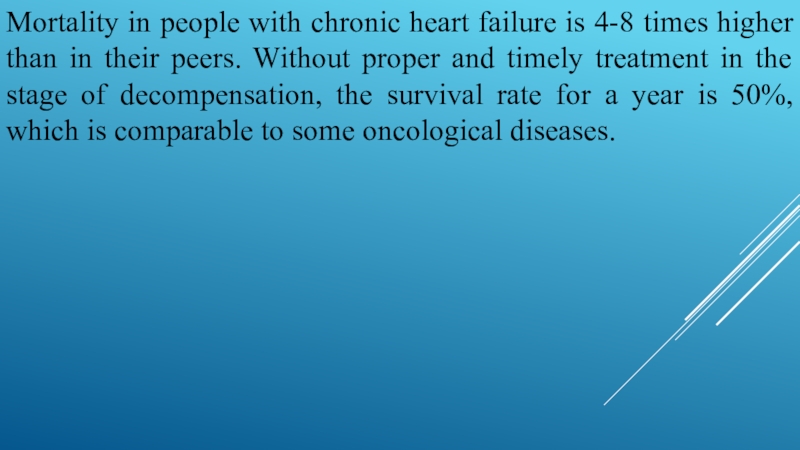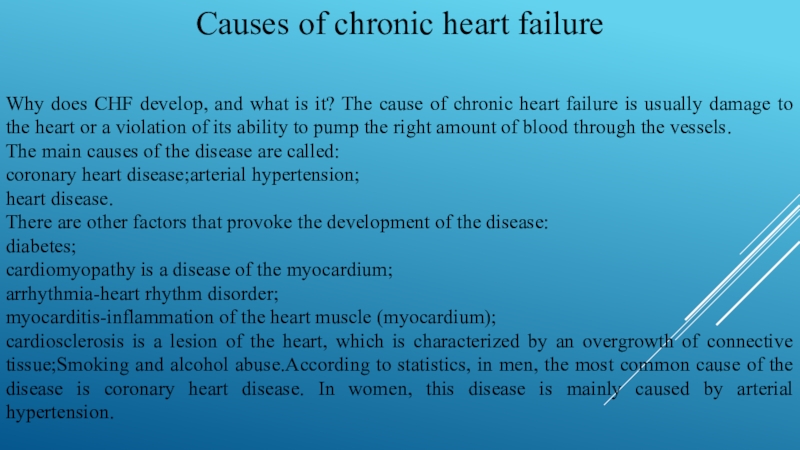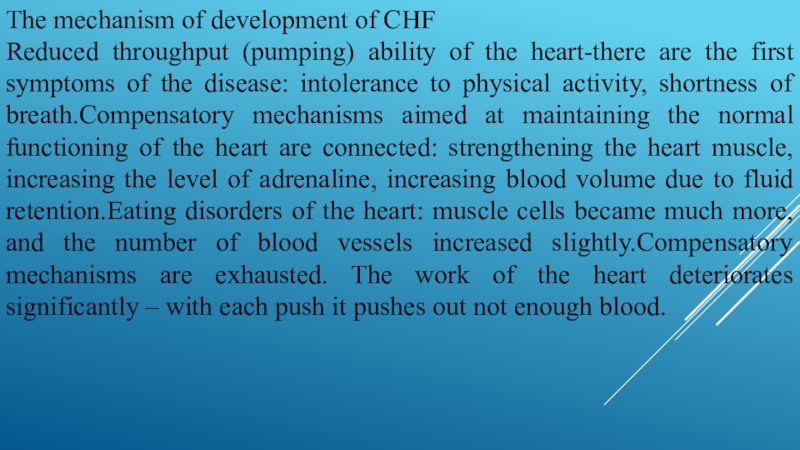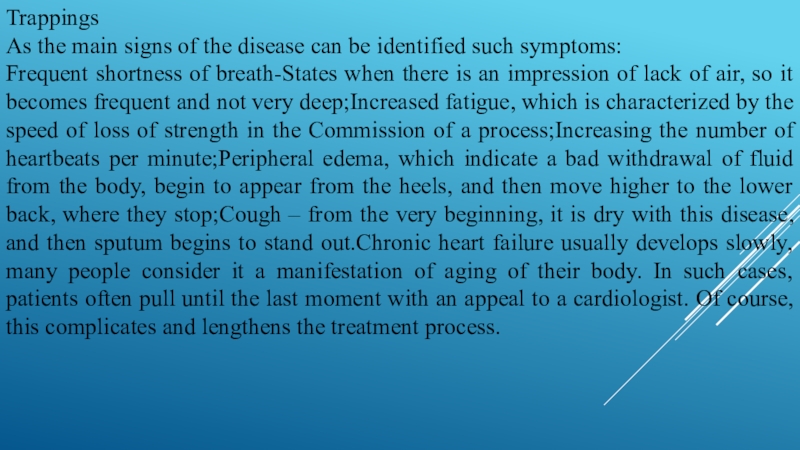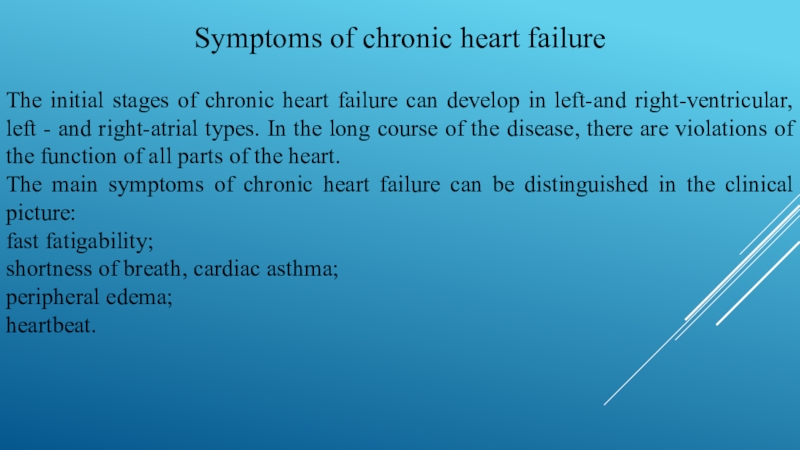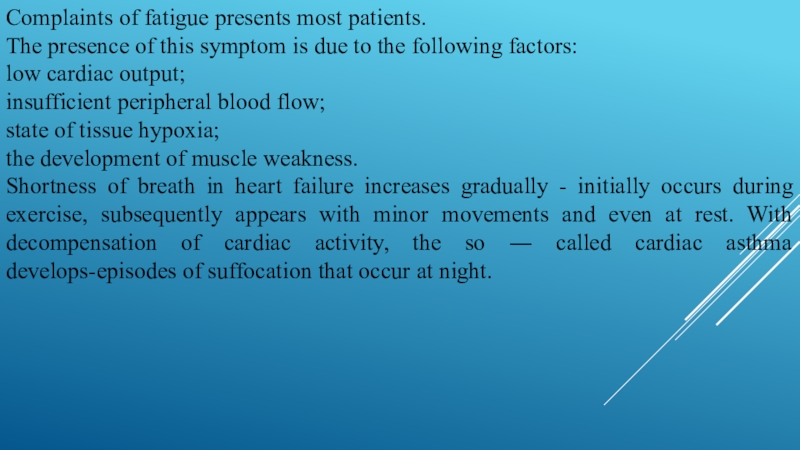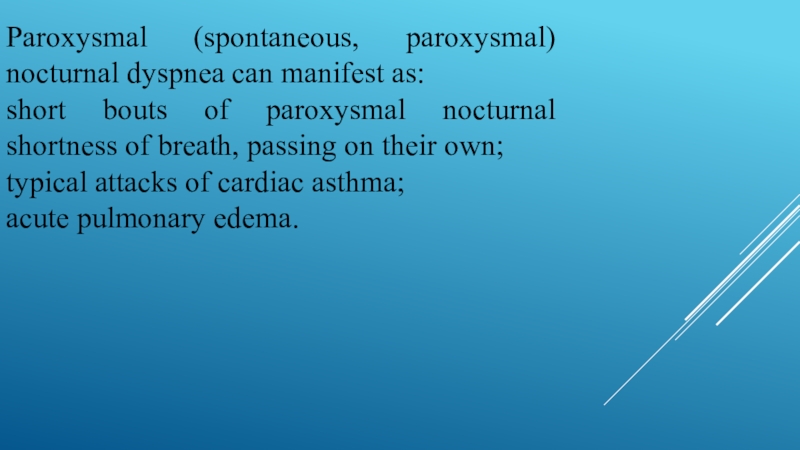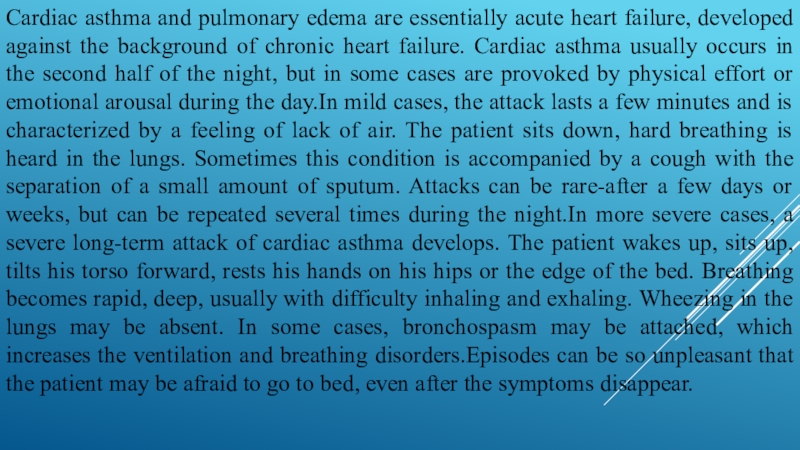- Главная
- Разное
- Образование
- Спорт
- Естествознание
- Природоведение
- Религиоведение
- Французский язык
- Черчение
- Английский язык
- Астрономия
- Алгебра
- Биология
- География
- Геометрия
- Детские презентации
- Информатика
- История
- Литература
- Математика
- Музыка
- МХК
- Немецкий язык
- ОБЖ
- Обществознание
- Окружающий мир
- Педагогика
- Русский язык
- Технология
- Физика
- Философия
- Химия
- Шаблоны, фоны, картинки для презентаций
- Экология
- Экономика
Презентация, доклад по английскому языку на тему : Сердечная недостаточность
Содержание
- 1. Презентация по английскому языку на тему : Сердечная недостаточность
- 2. Chronic heart failure (CHF) is a condition
- 3. heart failureacutechronicAcute heart failure can be associated
- 4. According to the classification by V. Kh.
- 5. H stage IIA-shortness of breath and palpitations
- 6. Depending on the phase of cardiac dysfunction
- 7. Depending on the zone of predominant stagnation
- 8. Depending on the results of the physical
- 9. Mortality in people with chronic heart failure
- 10. Causes of chronic heart failureWhy does CHF
- 11. The mechanism of development of CHFReduced throughput
- 12. TrappingsAs the main signs of the disease
- 13. Symptoms of chronic heart failureThe initial stages
- 14. Complaints of fatigue presents most patients. The
- 15. Paroxysmal (spontaneous, paroxysmal) nocturnal dyspnea can manifest
- 16. Cardiac asthma and pulmonary edema are essentially
- 17. ComplicationsPatients with chronic heart failure may develop
- 18. PreventionTo prevent heart failure, proper nutrition, sufficient
Chronic heart failure (CHF) is a condition in which the amount of blood released by the heart for each heartbeat decreases, that is, the pumping function of the heart drops, causing organs and tissues to lack
Слайд 2Chronic heart failure (CHF) is a condition in which the amount
of blood released by the heart for each heartbeat decreases, that is, the pumping function of the heart drops, causing organs and tissues to lack oxygen.
Слайд 3heart failure
acute
chronic
Acute heart failure can be associated with injuries, the action
of toxins, heart disease and without treatment can quickly lead to death. Chronic heart failure develops for a long time and is manifested by a complex of characteristic symptoms (shortness of breath, fatigue and decreased physical activity, swelling, etc.), which are associated with inadequate perfusion of organs and tissues at rest or under load and often with fluid retention in the body
Слайд 4According to the classification by V. Kh. Vasilenko, N. D. Strazhesko,
F. G. lang to the development of chronic heart failure there are three stages: I art. (HI) initial, or latent insufficiency, which manifests itself in the form of shortness of breath and palpitations only with significant physical activity, previously did not cause it. At rest, hemodynamics and organ functions are not impaired, the ability to work is somewhat reduced. Stage II-severe, prolonged circulatory failure, hemodynamic disorders (stagnation in the small circle of blood circulation) with little physical activity, sometimes at rest. In this stage, there are 2 periods: period A and period B.
classification
Слайд 5H stage IIA-shortness of breath and palpitations with moderate physical activity.
Indistinct cyanosis. As a rule, circulatory insufficiency mainly in the small circle of blood circulation: periodic dry cough, sometimes hemoptysis, manifestations of stagnation in the lungs (crepitation and silent wet rales in the lower parts), palpitations, interruptions in the heart. At this stage, there are initial manifestations of stagnation and in a large circle of blood circulation (small swelling on the feet and legs, a slight increase in the liver). By morning, these phenomena are reduced. Working capacity sharply decreases.
H IIB stage-shortness of breath at rest. All objective symptoms of heart failure are sharply enhanced: pronounced cyanosis, congestive changes in the lungs, prolonged aching pain, interruptions in the heart, palpitations; signs of circulatory insufficiency in the large circle of blood circulation, permanent swelling of the lower limbs and trunk, enlarged dense liver (cardiac cirrhosis of the liver), hydrothorax, ascites, severe oliguria join. Patients are unable to work.
Stage III (H III) - the final, dystrophic stage of insufficiency In addition to hemodynamic disorders, morphologically irreversible changes develop in organs (diffuse pneumosclerosis, liver cirrhosis, stagnant kidney, etc.). Disturbed metabolism, develops exhaustion of patients. Treatment is ineffective.
H IIB stage-shortness of breath at rest. All objective symptoms of heart failure are sharply enhanced: pronounced cyanosis, congestive changes in the lungs, prolonged aching pain, interruptions in the heart, palpitations; signs of circulatory insufficiency in the large circle of blood circulation, permanent swelling of the lower limbs and trunk, enlarged dense liver (cardiac cirrhosis of the liver), hydrothorax, ascites, severe oliguria join. Patients are unable to work.
Stage III (H III) - the final, dystrophic stage of insufficiency In addition to hemodynamic disorders, morphologically irreversible changes develop in organs (diffuse pneumosclerosis, liver cirrhosis, stagnant kidney, etc.). Disturbed metabolism, develops exhaustion of patients. Treatment is ineffective.
Слайд 6Depending on the phase of cardiac dysfunction isolated:
Systolic heart failure
(associated with a violation of the systole-the period of contraction of the ventricles of the heart);
Diastolic heart failure (associated with a violation of diastole-the period of relaxation of the ventricles of the heart);
Mixed heart failure (associated with a violation of both systole and diastole).
Diastolic heart failure (associated with a violation of diastole-the period of relaxation of the ventricles of the heart);
Mixed heart failure (associated with a violation of both systole and diastole).
Слайд 7Depending on the zone of predominant stagnation of blood is isolated:Right
ventricular heart failure (with stagnation of blood in the small circle of blood circulation, that is, in the vessels of the lungs);Left ventricular heart failure (with stagnation of blood in the large circle of blood circulation, that is, in the vessels of all organs except the lungs);Biventricular (dwukierunkowy) heart failure (with congestion in both circles of blood circulation).
Слайд 8Depending on the results of the physical examination, classes on the
Killip scale are determined:
I (no signs of CH);
II (weakly expressed CH, little wheezing);
III (more pronounced CH, more wheezing);
IV (cardiogenic shock, systolic blood pressure below 90 mmHg. St).
I (no signs of CH);
II (weakly expressed CH, little wheezing);
III (more pronounced CH, more wheezing);
IV (cardiogenic shock, systolic blood pressure below 90 mmHg. St).
Слайд 9Mortality in people with chronic heart failure is 4-8 times higher
than in their peers. Without proper and timely treatment in the stage of decompensation, the survival rate for a year is 50%, which is comparable to some oncological diseases.
Слайд 10Causes of chronic heart failure
Why does CHF develop, and what is
it? The cause of chronic heart failure is usually damage to the heart or a violation of its ability to pump the right amount of blood through the vessels.
The main causes of the disease are called:
coronary heart disease;arterial hypertension;
heart disease.
There are other factors that provoke the development of the disease:
diabetes;
cardiomyopathy is a disease of the myocardium;
arrhythmia-heart rhythm disorder;
myocarditis-inflammation of the heart muscle (myocardium);
cardiosclerosis is a lesion of the heart, which is characterized by an overgrowth of connective tissue;Smoking and alcohol abuse.According to statistics, in men, the most common cause of the disease is coronary heart disease. In women, this disease is mainly caused by arterial hypertension.
The main causes of the disease are called:
coronary heart disease;arterial hypertension;
heart disease.
There are other factors that provoke the development of the disease:
diabetes;
cardiomyopathy is a disease of the myocardium;
arrhythmia-heart rhythm disorder;
myocarditis-inflammation of the heart muscle (myocardium);
cardiosclerosis is a lesion of the heart, which is characterized by an overgrowth of connective tissue;Smoking and alcohol abuse.According to statistics, in men, the most common cause of the disease is coronary heart disease. In women, this disease is mainly caused by arterial hypertension.
Слайд 11The mechanism of development of CHF
Reduced throughput (pumping) ability of the
heart-there are the first symptoms of the disease: intolerance to physical activity, shortness of breath.Compensatory mechanisms aimed at maintaining the normal functioning of the heart are connected: strengthening the heart muscle, increasing the level of adrenaline, increasing blood volume due to fluid retention.Eating disorders of the heart: muscle cells became much more, and the number of blood vessels increased slightly.Compensatory mechanisms are exhausted. The work of the heart deteriorates significantly – with each push it pushes out not enough blood.
Слайд 12Trappings
As the main signs of the disease can be identified such
symptoms:
Frequent shortness of breath-States when there is an impression of lack of air, so it becomes frequent and not very deep;Increased fatigue, which is characterized by the speed of loss of strength in the Commission of a process;Increasing the number of heartbeats per minute;Peripheral edema, which indicate a bad withdrawal of fluid from the body, begin to appear from the heels, and then move higher to the lower back, where they stop;Cough – from the very beginning, it is dry with this disease, and then sputum begins to stand out.Chronic heart failure usually develops slowly, many people consider it a manifestation of aging of their body. In such cases, patients often pull until the last moment with an appeal to a cardiologist. Of course, this complicates and lengthens the treatment process.
Frequent shortness of breath-States when there is an impression of lack of air, so it becomes frequent and not very deep;Increased fatigue, which is characterized by the speed of loss of strength in the Commission of a process;Increasing the number of heartbeats per minute;Peripheral edema, which indicate a bad withdrawal of fluid from the body, begin to appear from the heels, and then move higher to the lower back, where they stop;Cough – from the very beginning, it is dry with this disease, and then sputum begins to stand out.Chronic heart failure usually develops slowly, many people consider it a manifestation of aging of their body. In such cases, patients often pull until the last moment with an appeal to a cardiologist. Of course, this complicates and lengthens the treatment process.
Слайд 13Symptoms of chronic heart failure
The initial stages of chronic heart failure
can develop in left-and right-ventricular, left - and right-atrial types. In the long course of the disease, there are violations of the function of all parts of the heart.
The main symptoms of chronic heart failure can be distinguished in the clinical picture:
fast fatigability;
shortness of breath, cardiac asthma;
peripheral edema;
heartbeat.
The main symptoms of chronic heart failure can be distinguished in the clinical picture:
fast fatigability;
shortness of breath, cardiac asthma;
peripheral edema;
heartbeat.
Слайд 14Complaints of fatigue presents most patients.
The presence of this symptom
is due to the following factors:
low cardiac output;
insufficient peripheral blood flow;
state of tissue hypoxia;
the development of muscle weakness.
Shortness of breath in heart failure increases gradually - initially occurs during exercise, subsequently appears with minor movements and even at rest. With decompensation of cardiac activity, the so ― called cardiac asthma develops-episodes of suffocation that occur at night.
low cardiac output;
insufficient peripheral blood flow;
state of tissue hypoxia;
the development of muscle weakness.
Shortness of breath in heart failure increases gradually - initially occurs during exercise, subsequently appears with minor movements and even at rest. With decompensation of cardiac activity, the so ― called cardiac asthma develops-episodes of suffocation that occur at night.
Слайд 15Paroxysmal (spontaneous, paroxysmal) nocturnal dyspnea can manifest as:
short bouts of paroxysmal
nocturnal shortness of breath, passing on their own;
typical attacks of cardiac asthma;
acute pulmonary edema.
typical attacks of cardiac asthma;
acute pulmonary edema.
Слайд 16Cardiac asthma and pulmonary edema are essentially acute heart failure, developed
against the background of chronic heart failure. Cardiac asthma usually occurs in the second half of the night, but in some cases are provoked by physical effort or emotional arousal during the day.In mild cases, the attack lasts a few minutes and is characterized by a feeling of lack of air. The patient sits down, hard breathing is heard in the lungs. Sometimes this condition is accompanied by a cough with the separation of a small amount of sputum. Attacks can be rare-after a few days or weeks, but can be repeated several times during the night.In more severe cases, a severe long-term attack of cardiac asthma develops. The patient wakes up, sits up, tilts his torso forward, rests his hands on his hips or the edge of the bed. Breathing becomes rapid, deep, usually with difficulty inhaling and exhaling. Wheezing in the lungs may be absent. In some cases, bronchospasm may be attached, which increases the ventilation and breathing disorders.Episodes can be so unpleasant that the patient may be afraid to go to bed, even after the symptoms disappear.
Слайд 17Complications
Patients with chronic heart failure may develop dangerous conditions such as
frequent
and prolonged pneumonia;
pathological myocardial hypertrophy;
multiple thromboembolism due to thrombosis;
General exhaustion;
violation of heart rhythm and conduction of the heart;
impaired liver and kidney function;
sudden death from cardiac arrest;
thromboembolic complications (heart attack, stroke, pulmonary embolism).
pathological myocardial hypertrophy;
multiple thromboembolism due to thrombosis;
General exhaustion;
violation of heart rhythm and conduction of the heart;
impaired liver and kidney function;
sudden death from cardiac arrest;
thromboembolic complications (heart attack, stroke, pulmonary embolism).
Слайд 18Prevention
To prevent heart failure, proper nutrition, sufficient physical activity, rejection of
bad habits are necessary. All diseases of the cardiovascular system should be promptly identified and treated.
